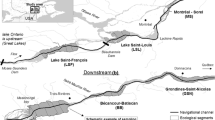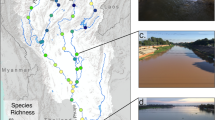Abstract
Fish community structure can be considered at several scales. The watershed is the largest geographic unit connecting freshwater systems. It describes the upstream-downstream gradient resulting from changes in flow rates. The watershed can also extend over distinct ecological regions. The number of native fish species recorded in each sub-watershed directly connected to the Rhône is strongly correlated with the area of the sub-watershed. Three major groups of sub-watersheds can be retained as ichthyogeographic regions: the Saône region, dominated by a large alluvial plain and rich in species, the Isère region representing the north and central Alpine rivers and the Durance region, strongly influenced by the Mediterranean climate. The River Rhône basin reveals a high diversity of native faunal regions which have to be considered in monitoring and managing the network.
Similar content being viewed by others
References
Allardi, J. & P. Keith, 1991. Atlas préliminaire des poissons d'eau douce de France. Muséum National d Histoire Naturelle de Paris/ Conseil Supérieur de la Pêche/ Centre National du Machinisme Agricole du Génie Rural, des Eaux et des Forêts/ Ministère de l'Environnement, Paris, 232 pp.
Angermeier, P. L. & I. J. Schlosser, 1983. Species-area relationships for stream fishes. Ecology 70: 1450–1462.
Bailey, R. G., 1989. Ecoregions of the continents. Envir. Conserv. 16: 307–310.
Bayley, P. B. & H. W. Li, 1992. Riverine fishes. In P. Calow & G. E. Petts (eds), The rivers handbook: Hydrological and ecological principles. Blackwell, Oxford: 251–281.
Beecher, H. A., E. R. Dott & R. F. Fernau, 1988. Fish species and stream order in Washington State streams. Envir. Biol. Fishes 22: 193–209.
Changeux, T. & D. Pont. Current status of the endemic riverine fishes of the french mediterranean basin. Biol. Conserv. In press.
Chessel, D. & S. Dolédec, 1992. ADE Software, Multivariate analyses and graphical display for environmental data user's manual, version 3.3, Cl. Bernard Univ., Lyon, France: 332 pp.
Dolédec, S. & D. Chessel. Recent developments in linear ordination methods for environmental sciences. In Council of Scientific Research Integration (ed.), Trends in Ecology. Research Trends publishers, India. In press.
Dupias, G. & P. Rey, 1985. Carte des régions écologiques de la France 1/1 000 000ème, document pour un zonage des régions phyto-écologiques. CNRS (ed.), Toulouse, France.
Horwitz, R. J., 1978. Temporal variability patterns and the distributional patterns of stream fishes. Ecol. Monogr. 48: 307–321.
Huet, M., 1954. Biologie, profils en long et en travers des eaux courantes. Bull. fr. Piscic. 175: 41–53.
Hughes, R. M., E. Rextad & C. E. Bond, 1987. The relationship of aquatic ecoregion, river basins, and physiographic provinces to ichthyogeographic regions of Oregon. Copeia 1987: 423–432.
Jackson, D. A. & H. H. Harvey, 1989. Biogeographic associations in fish assemblages: local vs regional processes. Ecology 70: 1472–1484.
Jackson, D. A., K. M. Somers & H. H. Harvey, 1992. Null models and fish communities: evidence of non random pattern. Am. Nat. 139: 930–951.
Larsen, D. P., J. M. Omernik, R. M. Hughes, D. R. Dudley, C. M. Rohm, T. R. Whittier, A. J. Kinney & A. L. Gallant, 1986. The correspondence between spatial patterns in fish assemblages in Ohio streams and aquatic ecoregions. Envir. Mgmt. 10: 815–828.
Legendre, P. & V. Legendre, 1983. Postglacial dispersal of freshwater fishes in the Quebec peninsula. Can. J. Fish. aquat. Sci. 41: 1781–1802.
MacArthur, R. H., 1965. Patterns of species diversity. Biol. Rev. 40: 510–533.
Mahon, R., 1984. Divergent structure in fish taxocenes of north temperate streams. Can. J. Fish. aquat. Sci. 41: 330–350.
Monjuvent, G., P. Ambert, E. Bonifay, A. Bonnet, M. Campy, G. Clauzon, E. Colomb, M. Dubar, R. Fleury, J. Gabert, M. Jorda, M. Julian, A. L'Homer, P. Mandier, P. Rat & M. Roux, 1984a. Riss, paléogr'eographie au 1/1 500 000ème. In BRGM (ed.), Synthèse géologique du sud-est de la France, Atlas. Debrand-Passard, planche Q2.
Monjuvent, G., J. C. Aloîsi, P. Ambert, E. Bonifay, A. Bonnet, M. Campy, G. Clauzon, E. Colomb, C. Dorthe-Monachon, M. Dubar, R. Fleury, C. Froget, J. Gabert, M. Jorda, M. Julian, A. L'Homer, P. Mandier, A. Monaco, N. Mongereau, G. Nicoud, P. Rat & M. Roux, 1984b. Würm, paléogéographie au 1/1 500 000ème. In BRGM (ed.), Synthèse géologique du sud-est de la France, Atlas. Debrand-Passard, planche Q3.
Osborne, L. L. & M. J. Wiley, 1992. Influence of tributary spatial position on the structure of warmwater fish communities. Can. J. Fish. aquat. Sci. 49: 671–681.
Osborne, L. L., S. L. Kohler, P. B. Bayley, D. M. Day, W. A. Bertrand, M. J. Wiley & R. Sauer, 1992. Influence of stream location in a drainage network on the index of biotic integrity. Trans. am. Fish. Soc. 121: 635–643.
Pagney, P., 1988. Climats et cours d'eau de France. Masson, Paris, 248 pp.
Persat, H. & P. Berrebi, 1990. Relative ages of present population of Barbus barbus and Barbus meridionalis (Cyprinidae) in southern France: preliminary considerations. Aquat. Living Resour. 3: 253–263.
Rohm, C. M., J. W. Giese & C. C. Bennett, 1987. Evaluation of an aquatic ecoregion classification of streams in Arkansas. J. Freshwat. Ecol. 4: 127–140.
Ross, H. H., 1963. Stream communities and terrestial biomes. Arch. Hydrobiol. 59: 235–242.
Souchon, Y. & F. Trocherie, 1990. Technical aspects of french legislation dealing with the freshwater fishery (June 1984): ‘Fisheries orientation schemes’ and ‘Fishery ressources management plans’. In W. L. T. Van Densen, B. Steinmetz & R. H. Hughes (eds), Management of freshwater fisheries. Pudoc, Wageningen, The Netherlands: 190–214.
Thioulouse, J., 1991. MacDendro© software. Cl. Bernard Univ., Lyon, France.
Tonn, W. M., J. J. Magnuson, M. Rask & J. Toivonen, 1990. Intercontinental comparison of small-Lake fish Assemblages, the balance between local and regional processes. Am. Nat. 136: 345–375.
Vannote, R. L., G. W. Minshall, K. W. Cummins, J. R. Sedell & C. E. Cushing, 1980. The river continuum concept. Can. J. Fish. aquat. Sci. 37: 130–137.
Whittier, T. R. & R. M. Hughes, 1988. Correspondence between ecoregion and spatial patterns in stremm ecosystems in Oregon. Can. J. Fish. aquat. Sci. 45: 1264–1278.
Author information
Authors and Affiliations
Rights and permissions
About this article
Cite this article
Changeux, T., Pont, D. Ichthyogeographic regions and watershed size in the French river Rhône network. Hydrobiologia 300, 355–363 (1995). https://doi.org/10.1007/BF00024476
Issue Date:
DOI: https://doi.org/10.1007/BF00024476




